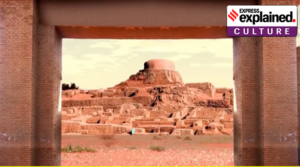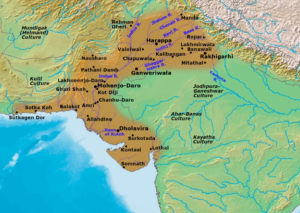Lothal, ‘oldest dock in the world’, to get heritage complex
Why in News?
Recently, the Prime Minister has reviewed the construction of the National Maritime Heritage Complex (NMHC) site at Gujarat’s Lothal.
What is the National Maritime Heritage Complex?
- The project began in March 2022, and is being developed at a cost of Rs 3,500 crore.
- It will have several innovative features such as Lothal mini-recreation, which will recreate Harappan architecture and lifestyle through immersive technology.
- It has four theme parks – Memorial theme park, Maritime and Navy theme park, Climate theme park, and Adventure and Amusement theme park.
- It will act as a center for learning and understanding India’s maritime history.
- The NMHC is being developed with the aim of displaying India’s diverse maritime heritage and also help Lothal emerge as a world-class international tourist destination.
Where is Lothal?
- About:
- Lothal was one of the southernmost sites of the Indus Valley civilization (IVC), located in the Bhāl region of what is now the state of Gujarat.
- The port city is believed to have been built in 2,200 BC.
- Lothal was a thriving trade center in ancient times, with its trade of beads, gems and ornaments reaching West Asia and Africa.
- The meaning of Lothal (a combination of Loth and (s) thal) in Gujarati is “the mound of the dead.
- Incidentally, the name of the city of Mohenjo-daro (also part of the Indus Valley Civilisation, now in Pakistan) means the same in Sindhi.
- Lothal had the world’s earliest known dock, which connected the city to an ancient course of the Sabarmati River on the trade route between Harappan cities in Sindh and the peninsula of Saurashtra.
- Discovery:
- Indian archaeologists started the search for cities of the Harappan Civilisation post-1947 in Gujarat’s Saurashtra.
- Archaeologist SR Rao led the team which discovered a number of Harappan sites at the time, including the port city of Lothal.
- Excavation work was carried out in Lothal between February 1955 and May 1960.
- Identification of Dockyard:
- The National Institute of Oceanography in Goa discovered marine microfossils and salt, gypsum crystals at the site, indicating that sea water once filled the structure and it was definitely a dockyard.
- In later excavations, ASI unearthed a mound, a township, a marketplace, and the dock.
- Adjacent to the excavated areas stands the archaeological site museum, where some of the most prominent collections of Indus-era antiquities in India are displayed.
What is the Heritage Value of Lothal?
- Lothal was nominated in April 2014 as a UNESCO World Heritage Site, and its application is pending on the tentative list of UNESCO.
- The excavated site of Lothal is the only port-town of the Indus Valley Civilisation.
- Its heritage value is comparable to other ancient port-towns around the world including,
- Xel Ha (Peru)
- Ostia (Port of Rome) and Carthage (Port of Tunis) in Italy
- Hepu in China
- Canopus in Egypt
- Gabel (Byblos of the Phoenicians)
- Jaffa in Israel
- Ur in Mesopotamia
- Hoi An in Vietnam
- In the region, it can be compared with other Indus port towns of Balakot (Pakistan), Khirasa (in Gujarat’s Kutch) and Kuntasi (in Rajkot).
What are the Important Sites of IVC?
- Harappa in present Pakistan – granaries with big platform, stone symbol of lingam and yoni, mother goddess figure, wheat and barley in wooden mortar, dice, copper scale and mirror.
- Mohenjo–daro in present Pakistan – bronze dancing girl, the sculpture of bearded priest, the great bath, the great granary.
- Dholavira in Gujarat – giant water reservoir, unique water harnessing system, stadium, dams and embankments, inscription comprising 10 large sized signs like an advertisement board.
- Ropar in Punjab – dog buried with human oval pit burials.
- Balathal and Kalibangan in Rajasthan – bangle factory, toy carts, bones of camel, decorated bricks, citadel and lower town.
- Banawali in Haryana – toy plough, barley grains, oval-shaped settlement, the only city with radial streets.
- Alamgirpur in Uttar Pradesh – impression of a cloth on a trough.
UPSC Civil Services Examination Previous Year Question (PYQ)
Prelims
Q1. Which one of the following ancient towns is wellknown for its elaborate system of water harvesting and management by building a series of dams and channelizing water into connected reservoirs? (2021)
(a) Dholavira
(b) Kalibangan
(c) Rakhigarhi
(d) Ropar
Ans: (a)
Q2. Which of the following characterizes/characterize the people of Indus Civilization? (2013)
- They possessed great palaces and temples.
- They worshipped both male and female deities.
- They employed horse-drawn chariots in warfare.
Select the correct statement/statements using the codes given below:
(a) 1 and 2 only
(b) 2 only
(c) 1, 2 and 3
(d) None of the statements given above is correct
Ans: (b)
Q3. Which one of the following is not a Harappan site? (2019)
(a) Chanhudaro
(b) Kot Diji
(c) Sohgaura
(d) Desalpur
Ans: (c)
Mains
- To what extent has the urban planning and the culture of the Indus Valley Civilization provided inputs to the present-day urbanization? Discuss. (2014)





